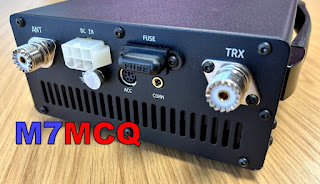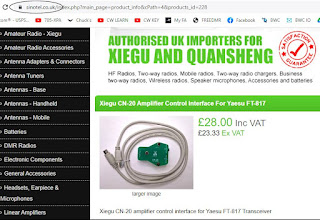BARGAIN AMP & TUNER
I recently came across the opportunity to buy a £540 AMP/ATU combo (with extras) for a very very low price and I initially told myself that I had no use for such a thing, but then the devil on my shoulder told me I'd be an absolute fool to walk away from such a bargain and pointed out that after I'd experimented with it for a while I'd be able to sell it and make some profit!
So I thought 'what the hell'....
The XPA-125B hit the UK shelves about 3 years ago and has enjoyed good sales. Obviously, it was immediately popular with Xiegu X6100 radio owners, but has since found popularity with other radios users like the FT-817/818 and IC-705. I have both these models so I'm keen to experiment with them along with my (tr)uSDX and Prepcomm MMX.
In this post I will initially only be looking at the XPA125B as an amplifier for use with NON-XIEGU radios! Later, I will add a section on the X6100.
The amp is supposedly capable of producing 100W from a 1-5W input and in some cases it has reportedly produced 125W. There's a 30A blade fuse in the back of the case so I replaced it straight away with a 20A fuse just to be on the safe side. I'm well aware that an amp in the wrong hands can be a dangerous thing, so I'll be exercising great caution when connecting radios to it.
When the amp arrived, it was good to see that it was in MINT+++ condition and just as the seller had claimed, it clearly hadn't seen any use other than a couple of holiday outings away from home...
It also came with a pretty handy accessory in the form of the XIEGU CE-19 which apparently makes data-modes an absolute breeze along with a bunch of leads.
 |
| 3 minute tx on FM - 52 degrees |
Using SSB into a dummy load, the FT-818's lowest TX power peaked around 90W output from the amp and the radio's highest output peaked around 107W, so there's absolutely no point in using anything more than half a watt to drive the amp.
I’d prefer it if the amp’s power-levels dropped in relation to the input, but they barely change, so basically, there’s little power adjustment with an 818 connected (like there is on Elecraft amps (at 3 times the price)).
The XPA125B has a bright LCD display which provides all the information you require, but personally, I think it could have been better laid out - I've seen people on YouTube getting confused over what the various readings mean and I don't think the graphics serve much purpose. I think the "RX" should perhaps be changed to "PA". Of course once you understand the readouts, it's no big deal.
The top left and top right boxes show the SWR readings. With the ATU switched OFF, the left reading is the SWR at the radio and the right reading is the SWR at the antenna. Once you have performed a tune, you will see the readings drop according to how well the ATU could produce a match.
The bottom left and right readings show the amount of power from the radio (keep below 5W), while the bottom right reading shows the amount of power being sent to the antenna.
The reading in the bottom center is the currently selected Band and unless you are connected to a suitable Xiegu radio, you need to switch this manually each time you change bands. This of course is only important if the PA is ON and you are transmitting. If you are simply using the ATU to find a match, the PA will be switched off.
Finally, the top center readouts are for input voltage, current draw and PA temperature.
Here's a clearer diagram...
The built-in ATU works very well but not quite as good as an Elecraft. Its tuning range goes up to 500ohm so that's in the “Tune a wet noodle” range 😂 The only downside is that when it finds a match at say 1.3 it is reluctant to try again for a better match - it just won't retune - it's happy, so it thinks you should be too 😆
Using one of my EFHW antennas, I got great matches from 80-6M and an acceptable match on the Top Band. The ATU doesn't seem to have any memories which is a little odd considering that most other ATU's have hundreds. It's no big deal to me though because I tend not to rely on memories and prefer fresh tunes - it only takes a few seconds anyway.
Note the tuning process...
1) Switch off the PA
2) Increase the radio's output to around 5W (it won't tune up from very low power)
3) Key up in a constant carrier mode
4) Hold the amp's TUNE button for a couple of seconds
When you have your match, you can drop the radio's power back down and switch on the PA. So from this, you will see that there's virtually no automation with non-Xiegu radios 😮
You can see in the image below that I used a Samlex 30A mains PSU to power the XPA125B. Using my usual 8.4Ah Zippy FlightMax LifePO battery to power the amp wouldn't really be feasible considering that the amp could potentially draw 15-20A. That's why I'd prefer to have an option to reduce the amp's output.
I suppose the only way to go if you want to use the XPA125B out in the field would be to purchase a 20Ah LifePO4 battery, which would probably last a few hours on SSB - enough for most people.
It's all hypothetic for me anyway, since I neither need nor want to use 100W, so I'll be selling this lovely bit of equipment to someone who can benefit from it.
Overall though, I think the Xiegu is a cracking bit of kit and it's flexible enough to work with a great many radios as long as you're willing to manually change bands. After a full day of testing and playing around, the amp performed flawlessly and never went near the limit of its operating temperature - even the outer casing had no hot-spots.
I found a neat little carry-bag online (£8) and while it won't offer protection from hard knocks, it will certainly protect it from the usual scratches that these things collect during outings. It also has an inner pocket for leads.
ICOM IC-705 - XPA125B...
This mini-review probably sounds a bit negative and yes, there are some disappointing elements relating to the current lack of integration with Xiegu radios, but other than that, the XPA125B works really well and there's not many alternatives out there at this price. The price of the "interface leads" is also a bit disappointing considering that they're nothing special - you could make your own!
XIEGU XPA125B Specifications:
- Frequency Range: 0.5-54 MHzMaximum
- Output Power: 1.8-30 MHz >120 Watts / 50 MHz >90W
- Maximum Ambient Operation Temp: 130F Fahrenheit, 55c Celsius
- Gain: 13 dB (+/-2dB)
- Spurious Suppression: >50 dB
- Supply Voltage: 12-15 Volts DC
- Transmit Current Draw: @ max output 30 Amps
- Receive Current Draw: @ max 700 mA
- ATU Frequency Range: 1.8-30 MHz & 50-54 MHz
- ATU Tuning Range: 14-500 Ohms
- Dimensions: 10.3 x 6.3 x 2.8 inches (Excluding knobs, feets, handle etc)
- Weight: 2.65 Kg














No comments:
Post a Comment